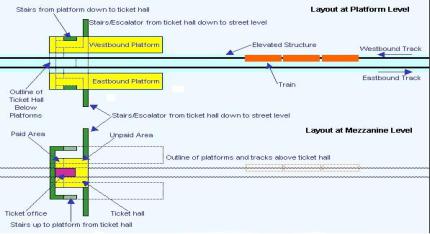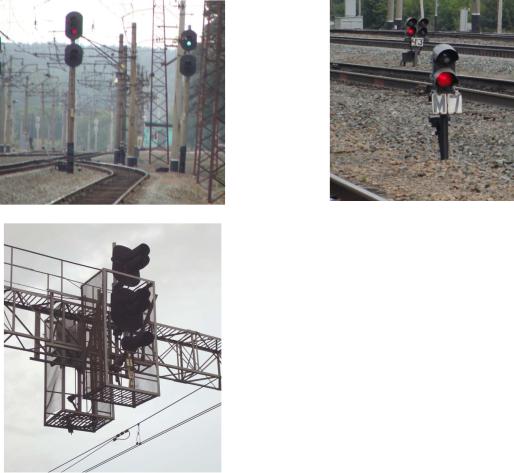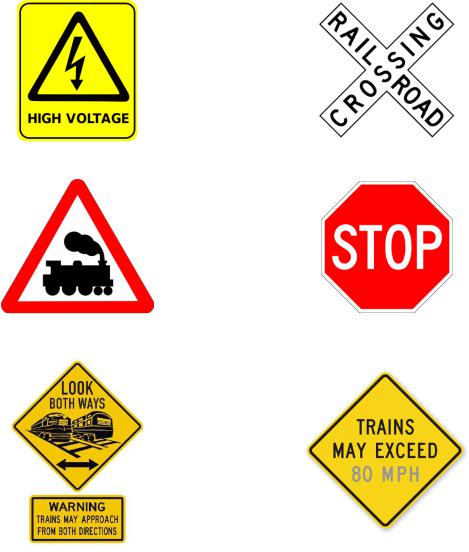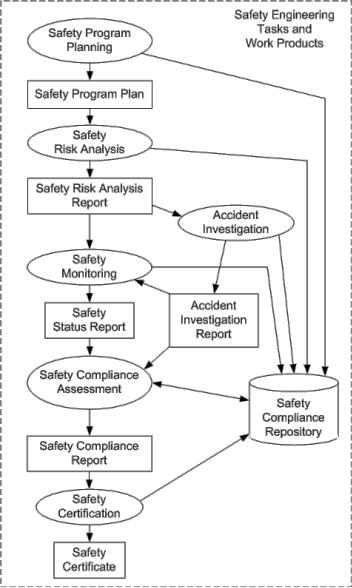
English_for_Transportation_Technology
.pdf
D
1. Side Platform Station
The basic station design used for a double track railway line has two platforms, one for each direction of travel. The series of examples in the following diagrams shows stations with right hand running as common in Europe and the Americas. Each platform has a ticket office and other passenger facilities such as toilets and perhaps refreshment or other concession. Where there is a high frequency service or for designs with high platforms, the two platforms are usually connected by a footbridge. In the case of a station where tickets are required to allow passengers to reach the platform, a "barrier" or, in the case of a metro with automatic fare collection, a "gate line", is provided to divide the "paid area" and "unpaid area".
This design allows equal access for passengers approaching from either side of the station but it does require the provision of two ticket offices and therefore staffing for both of them. Sometimes, stations with two ticket offices will man only one full time. The other will be manned as required at peak times.
2. Island Platform Station
A cheaper form of station construction, at least for a railway at grade level, is the island platform. As its name suggests, this is a single platform serving two tracks passing on either side, effectively creating an island which can only be accessed by crossing a track. A bridge or underpass is usually provided. Island platforms are usually wider than single platforms used for side platform stations but they still require less area. In the example shown above, there are two ticket offices, but one can be provided if preferred. Island platforms on elevated railways do require additional construction of the viaduct structure to accommodate the curves in the tracks needed to separate them on the approach to the platform.
3. Elevated Station with Side Platforms
Elevated railways are still popular in cities, despite their history of noise creation and generally unfriendly environmental image. The poor image has been considerably reduced with modern techniques of sound reduction and the use of reinforced and pre-stressed concrete structures. They are considerably cheaper than underground railways (at least half the price, sometimes considerably less than that) and can be operated with reduced risk of safety and evacuation problems.
53
4. Elevated Station with Ticket Hall Below Platforms
In the example illustrated immediately above, the ticket office and gate lines are below the platform level. This can be done to allow one ticket office to serve both platforms but it requires the space to be available below track level and this, in turn, requires enough height in the structure. Since many stations are built at road intersections, the location of the station structure might have to permit road traffic to pass beneath it and this requires an adequate height structure to be built
http://en.wikipedia.org
Exercise 2. Discuss the advantages and disadvantages of each station design with a partner.
Exercise 3. Describe each station design using the pictures from Exercise 1.
Listening
Exercise 1. Listen and answer the questions
1)What is the yard master’s business?
2)What qualities does the position of the yard master require?
3)What is an advantage of working as a yard master?
Exercise 2. In the following script differentiate the words and put sentence marks. Then listen again and check.
Workingforarailroadoranindustrialplanttheyardmasterexaminestrainscheduleandswitchin gordersthenheorshegivesinstructionsforwhenandwheretrainsareassembledorturnedaround situationsmaydevelopacallfordecisiveactionandthoroughunderstandingofrollingequipmen tandthecargoaswellasthoroughknowledgeofswitchingsignalsand everythingassociatedwiththerailroadsafetyandefficiencyclearlytheyardmasterisapositiono fresponsibility
Exercise 5. Reproduce the information about the yard master’s business.
Key words |
|
buy a ticket beforehand |
купить билет заранее |
carry/ transport |
перевозить |
connect |
соединять |
station facilities |
станционные устройства |
footbridge |
пешеходный мост |
freight station |
грузовая станция |
get on the train |
сесть на поезд |
halt |
остановочная платформа |
interchange station (UK)/ transfer station (US) |
станция пересадки |
junction |
узловая станция |
offer/ suggest |
предлагать |
on request |
по требованию |
peak times |
час пик |
route |
маршрут |
terminal |
распорядительная станция |
underpass |
подземный переход |
timetable |
расписание |
controller (UK)/dispatcher (US) |
диспетчер |
carriage shed (UK)/car barn (US) |
место отстоя вагонов |
54

siding |
обгонный путь / проходной путь |
yardmaster |
дежурный по станции |
hump |
горка |
ladder |
стрелочная улица |
conductor rail |
контактный рельс |
releaseair |
выпустить воздух |
marshalling yard (UK)/ classification park (US) |
сортировочный парк |
inbound train |
прибывающий поезд |
outbound train |
отходящий поезд |
Checklist
Assess your progress in this unit. Say which statements are true about you.
1)I can discuss different types of station with my colleagues.
2)I can differentiate between British and American railway terms.
3)My listening and reading are good enough to understand most of each text in this unit.
4)I can use participles in my speech.
UNIT 10. SIGNALLING
Start up
Exercise 1. Discuss in pairs to answer the questions: What is signalling used for? What are the principle signal colours?
Exercise 2. Match the pictures (A–C) with the signals (1–3)
A B
1) a mast signal
2) a suspended signal
3) a ground signal
C
55
Exercise 3. Match the signal with its significance.
1) red |
a) warning signal |
2) yellow |
b) clear signal |
3) green |
c) restrictive signal |
Vocabulary
Exercise 1. Match a word in A with a definition in B.
|
A |
|
B |
1 |
relay |
a |
an electronic or relay based system which sets routes using information |
|
|
|
from a train describer and the timetable without the need for intervention |
|
|
|
by a signaller |
2 |
circuit |
b |
the two rails of a section of track, insulated at their ends |
3 |
short circuit |
c |
a low-resistance connection established by accident or intention between |
|
|
|
two points in an electric circuit |
4 |
interlocking |
d |
an act of putting a train into service from a station or depot or when they |
|
|
|
are reversed at a terminus |
5 |
automatic route setting |
e |
the visual indication of a colour light signal as displayed to the driver. |
6 |
block |
f |
a parallel track equal to the length of the longest train with a switch at |
|
|
|
each end connecting into the main track |
7 |
aspect |
g |
a fixed lineside signal showing light indications to drivers |
8 |
colour light signal |
h |
a length of track protected by a fixed signal which indicates to a driver |
|
|
|
when it is safe to proceed into the section |
9 |
passing siding |
i |
an arrangement of signal apparatus that prevents conflicting movements |
|
|
|
through an arrangement of tracks such as junctions or crossings |
10 |
dispatching |
j |
an electrically operated switch |
Exercise 2. Some words are often used together. Fill the gaps in sentences 1–6 with a word from the list that goes with the word in bold.
circuit |
aspect |
signal |
control |
current |
section |
1)After W. Robinson’s invention of the track ______ in 1872 this gave railroads the ability to signal blocks of rail lines.
2)The important principle is that more than one train must not be allowed to be in the same block______ on the same track at one time.
3)In the early years of the 20th century the semaphore signal began to be replaced by the colour light ______.
4)With centralised traffic_______, train movements over territories varying in length from a few kilometres to several hundred are controlled by signals electrically operated from onecentral point.
5)Track circuit involves the passing of electric______ through one of the running rails of a section of the line, then through a track relay and back through the other rail, thus completing the circuit.
6)Track circuits are short-circuited by the wheels and axles of a train, putting the signals to the rear of the train at the danger ______.
56

Did you know?
“Signalman” is a UK term for person employed to operate or supervise the control of signals. Traditionally housed in a signal box (a “tower” in the USA), more recently a control room, where the signalling controls are located. Politically correct grade now identified as “signaler” by Network Rail. Not to be confused with the same term used in the USA for a
“signal maintenance person”.
UK term “controller” means a person who allows crews to trains and issue “dispatch orders” to send train out. The function is similar to the “dispatcher” in the USA.
Translation and rendering
Exercise 1. Read the passage, define the main idea of it, and then render in Russian.
Railroad Signals, Safely Keeping Trains on the Move
Railroad signals are an integral part of railroading, without them there is absolutely no way trains could safely operate, particularly on single track lines. While signal displays and meanings often varied from railroad to railroad some of the most common types were the color-light signals (or tri-lights), searchlights, position-lights, and color-position lights with the tri-light the most popular today.
The first railroad signals came into use in 1832 on the New Castle & Frenchtown Railroad but really came of age in 1872 with the invention of the track circuit by William Robinson. This circuitry allowed for the steel rail's natural conductivity to be employed thus giving birth to automatic block signaling systems, the leader of which remains Union Switch & Signal created by George Westinghouse in 1881. The first electrified railroad signaling system was the semaphore. When the semaphore came into use in the 1860s it was still an unpowered system. Basically the semaphore worked on a blade system whereby the indication was dependent on the position of the blade. During the semaphore's infancy having proper sight of the signal during the nighttime hours proved, obviously to be a problem so later versions were equipped with red, yellow and green lenses so that railroad engineers could clearly see the indication being given. The most common semaphore type was the three-position, upperquadrant signal that was introduced around the beginning of the 20th century. It operated above the horizontal position with an upward-vertical blade meaning proceed, horizontal blade meaning stop, and a 45-degree position meaning caution. This type of semaphore can still be found in use today, over 100 years since it became the standard semaphore type in 1908.
The position-lights system used a standard yellow light usually with three lights arranged in a semicircle to the upper right and three to the lower left with one in the center. Depending on what type of indication the three-aligned lenses were giving (i.e., vertical, horizontal or diagonal) the train would either proceed, stop or some other cautionary measure (such as stop and proceed).
The searchlight would become one of the most popular railroad signals during the classic era of the 20th century. It was introduced in 1920 and used as only one lamp that displayed a green, yellow and red indication by way of rotating color lenses. It found use on dozens of classic railroads such as the Rock Island, Union Pacific and Atlantic Coast Line but the high amount of maintenance required to keep the colored lens system functioning has caused it to fall out of favor for the much easier maintained tri-light signal.
57
Color-light signals came into use around 1914 and are essentially an inverted highway stoplight with green above (proceed), centered-yellow (caution) and restricted below. However, other versions of this railroad signal include the triangle design, which operates basically in the same fashion just with a different layout. Railroad signals, historically and even today are a lot more complicated, in terms of their meaning than your basic highway stoplight. To begin railroad signals serve to functions, protection and control and there are two different types; permissive and absolute. A permissive signal provides only protection within a given block (meaning a section of signaled track along a rail line having several blocks between Point A and Point B, each protected by a set of signals) while an absolute signal provides both protection and control (i.e., meaning it protects the block while also giving a train ruling instructions). For instance, when a permissive signal gives a red indication this means stop and proceed while an absolute signal displaying a red indication means stop and do not proceed without further dispatcher instructions.
After William Robinson's invention of the track circuit in 1872 this gave railroads the ability to signal blocks of rail lines. The first system was the Automatic Block Signal which used a masted-signal illuminating red, yellow or green to give an indication. It worked by using lowvoltage batteries along the block and as long as the rails were clear of trains a green, proceed indication was shown but when a train entered the block it broke the circuit with both signals then displaying red, or restricted.
Centralized Traffic Control, the most commonly used signaling system today uses both ABS and dispatchers to control the movement of trains as an extra measure of safety. So, just because a signal may display a green, proceed indication the train cannot move without verbal permission from the dispatcher (unless it has already been given permission beforehand to pass through the upcoming block). Other signaling systems that were once or are still in use include Direct Traffic Control (DTC), Form D Control System (DCS) and Track Warrant Control (TWC).
Although it has been mentioned several times above railroad signal displays (green, yellow, and red) mean three things. First, aspect is what the signal is displaying such as clear to proceed (green) or restricted to stop (red); second, indication is the instruction the display is giving; and finally third, the name of the display given (i.e., restricted, proceed, diverging clear).
Exercise 2. Read the following passage, title it and render in English.
Управление движением поездов основано на системе сигнализации, централизации и блокировки (СЦБ).
Сигнализация – система видимых и звуковых сигналов, обеспечивающих безопасность движения поездов. Основные сигнальные цвета: красный, желтый и зеленый. Красный свет означает запрещение движения, желтый – снижение скорости при движении, зеленый – разрешение движения.
Автоблокировка – система регулирования движения поездов. Железная дорога делится на блок-участки длиной 1–3 км, электрически изолированные друг от друга. В основу системы заложен принцип: на каждом блок-участке может находиться только один поезд. В каждую рельсовую цепь с одного конца включают источник питания, с другой – реле, которое управляет контактной системой включения светофоров. Когда первые колеса поезда пересекают границы блок-участка, реле изменяет на светофоре разрешающий (зеленый) огонь на запрещающий (красный).
Работой стрелок и сигналов управляет из поста централизации один человек – дежурный по станции (station operator). Диспетчерская централизация возможна только
58
на тех участках ж.д., которые оборудованы автоблокировкой и электрической централизацией стрелок и сигналов. При диспетчерской централизации управление движением всех поездов на участках осуществляется поездным диспетчером из единого центра, в который поступают все данные о движении поезда, о показаниях светофоров, о состоянии путей и т.д. Перед диспетчером расположено светящееся табло, на котором он прокладывает маршрут каждого поезда.
http://ru.wikipedia.org
Speaking
Exercise 1. Work in small groups. Choose one of the following topics. Be ready to explain the features of chosen signals to the class.
1)Railway line signals.
2)Station signals.
3)Marshalling yard signals.
4)A dispatching centre (Moscow, Novosibirsk, Sverdlovsk, Krasnoyarsk, etc.)
Writing
Exercise 1. Read the article below. Write an abstract to this text using recommendations in Appendix 6.
Dubinin D.A.
Information Technologies in Business Faculty
Information Technologies on Railway Transport Abroad
The historical analysis of the problem of the development of Information Technologies in some EU countries may help us to improve similar processes in the transportation industry in the Russian Federation.
Among the major tasks of the development of high-speed rail transportation in our country within the Strategy for Developing Rail Transport to 2030 is the following: to develop technical rules and national standards oriented to positive global experience in high-speed railway management and construction. The process of identifying the best national and international practices is known as benchmarking that we may apply to the railway industry in Russia. Some positive experience in the development of Information Technologies of the DLR (UK), the SNCF (France), the Deutsche Bahn (Germany) will be considered further.
The Docklands Light Railway (the DLR) is an automated light metro or light rail system opened in 1987 to serve the redeveloped Docklands area of London. DLR trains are monitored by a central computer, which compares the position of each vehicle with a stored schedule. All DLR trains are fitted with Automatic Train Protection (ATP). This means each train runs in its own safety zone that no other train can enter. ATP also regulates the maximum speed at which trains may operate. The highest speed on the railway is 80 kmph (50 mph).
Passenger service agents can drive trains in manual mode with the security of ATP. The controller has an overview of the entire railway and controls all signalling and points. These can be operated via the system management centre computer. SELTrac system appears to be a prototype for Russian analogues.
The SNCF is France’s national state-owned railway company. The SNCF operates the country’s national rail services, including the TGV, Franc’s high-speed rail network, which uses Communications-Based Train Control (CBTC). This is a railway signalling system that
59
makes use of the telecommunications between the train and track equipment for the traffic management and infrastructure control. By means of the CBTC system, the exact position of a train is known more accurately than with the traditional signalling systems. This results in a more efficient and safe way to manage the railway traffic. The CBTC system can also be a prototype for Russian analogues.
The Intercity-Express group (ICE) by Deutsche Bahn consists of high-speed trains running in Germany. The LZB system they use is a cab signalling and train protection system. It is also applied for Austrian railway lines and the AVE in Spain. The control center communicates with the train using two conductor cables that run between the tracks and are crossed every 100 m. The control center sends data packets, known as telegrams, to the vehicle which give its movement authority (how far it can proceed and at what speed) and the vehicle sends back data packets indicating its configuration, braking capabilities, speed, and position.
Russian “Sapsan” is an analogue of ICE trains.
In conclusion it should be noted that according to the Strategy for Developing Rail Transport to 2030 the amount of high-speed rail track in Russia will grow almost 17 times over – from the current 650km to 10,887km. Experience of using fast trains in France, UK and Germany shows that they require the railway tracks to be in good condition, and high demands for energy systems, technical service systems and rolling stock.
Key words |
|
aspect |
показание светофора |
block |
участок пути |
block section |
блок-участок, блок-перегон |
clear signal |
разрешающий сигнал |
colour-light signals |
светофор |
controller (UK) /dispatcher (US) |
диспетчер |
de-energize |
отключить питание (сети) |
dispatching |
отправление (поездов) |
ground signal |
карликовый светофор |
interlocking |
централизация стрелок |
mast signal |
мачтовый светофор |
passing siding |
дополнительный путь |
relay |
реле |
restrictive signal |
запрещающий сигнал |
route setting |
установка маршрута |
short circuit |
короткое замыкание |
short out |
зд. замкнуть накоротко |
suspended signal |
висячий светофор |
track circuit |
рельсовая цепь |
traffic safety |
безопасность движения |
warning signal |
предупреждающий сигнал |
Checklist
Assess your progress in this unit. Say which statements are true about you.
1)I can use key words to discuss signaling with my colleagues.
2)I can differentiate between British and American railway terms.
3)I can use infinitives in my speech.
4)My listening and reading are good enough to understand most of each text in this unit.
60

UNIT 11. SAFETY REQUIREMENTS IN MAINTENANCE DOCUMENTATION
Start up
Exercise 1. Warning signs can indicate any potential hazard, obstacle or condition requiring special attention. Look at the pictures and say what instructions these signs give. When we give instructions, we use the infinitive of the verb. To give a warning or prohibit an action we use do not.
Example: A. Do not touch! The object is under high voltage.
A B
C D
E F
Exercise 2. Safety Engineering is the activity consisting of the cohesive collection of all tasks that are primarily performed to ensure that the acceptable level of safety risk of an endeavor and its work products is not exceeded. Look at the scheme and say how unified standards ensure safety in Europe. The connectors below the picture will help you.
61
.
Words to introduce a chain of events |
First(ly), second(ly), then, thus, such as, after, finally |
|
|
Words expressing result |
So, as a result |
|
|
Vocabulary
Exercise 1. There are a number of words to describe development and management of safety. Fill in the gaps in the text with the words from the box.
a) rules |
b) regulations |
c) migration |
d) technical specification |
|
|
|
|
e) technical standards |
f) safety |
g) legislation |
h) technical requirements |
|
|
|
|
__________ (1) rules and standards, such as operating ________ (2), signalling rules, requirements on staff and ____________ (3) applicable to rolling stock have been devised mainly nationally. Under the _________ (4) currently in force, a variety of bodies deals with safety. These national safety rules, which are often based on national _________ (5), should gradually be replaced by rules based on common standards, established by ___________ (6) for interoperability (TSIs). The new national rues should be in line with Community
__________ (7) and facilitate __________ (8) towards a common approach to railway safety. The Commission has the power to suspend the implementation of a national safety rule for a maximum of six months.
62
